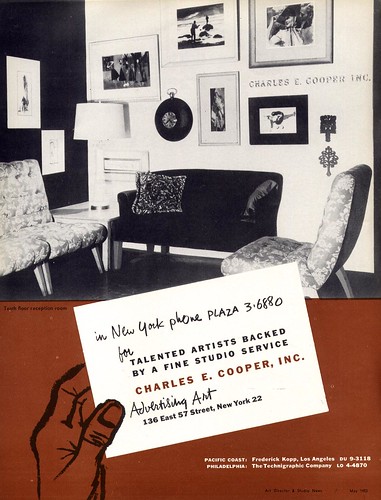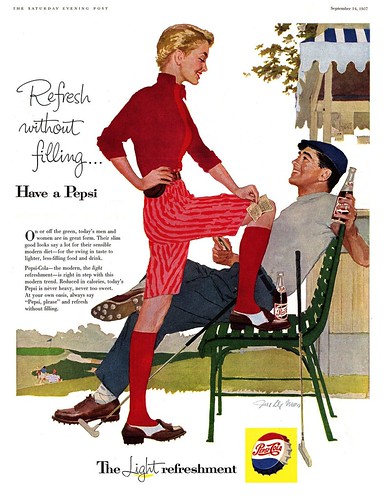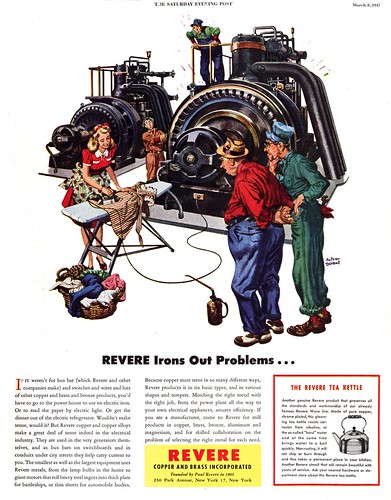
Fifty-plus years later, Rodewald's words still apply, thank goodness. Now, as then, children who love to doodle dream of growing up and getting paid to make pictures. If not for the needs of businesses, those kids would have only the fine arts/gallery circuit as an potential source of income... and the term "starving artist" didn't come from nowhere!
But times do change - and markets for illustration are not what they used to be. Fred C. Rodewald set out to tell "where to look for art jobs and what to expect of them." I thought it might be instructive for those of us who illustrate for a living (and those who hope to) to consider what the business was like then and how it compares to the business today.
Is this a great time to be an artist... or were we born fifty years too late?

Today, let's look at what Rodewald had to say about illustrating for the ad industry:
"Advertising agencies constitute the largest and perhaps the most lucrative sales outlet for commercial artists of all kinds. However, this is also the most competitive field. It is with the agencies that the practice of the so-called "package deal" - that is, selling design, illustration, lettering, and so on, as a single unit instead of separately - has become most prevalent. This has given studios and artists' representatives a tremendous and still growing competitive advantage over the individual free-lance."

"On the other hand, since the agencies usually have qualified art directors to do the art buying, the difficulties of inefficient buying practices are reduced to a minimum. Furthermore, the agencies have been in the van of the movement for improved ethical standards, as witness their sponsorship of the two codes of ethics."

"For the artist seeking salaried employment, the agencies offer opportunities to layout designers and renderers, and frequently, in the case of smaller agencies, also to letterers, illustrators, retouchers, and what is known as "good all-around artists."

Rodewald does not discuss pricing, but I think its important to have some idea what illustrators were paid for advertising work for the sake of modern day comparison. Mitchell Hooks, whom we looked at a couple of weeks ago, told us that several thousand dollars for one major magazine ad illustration, like the Joe De Mers Pepsi ad below, was not uncommon during the 1950's.

Confiming this amount is a great little anecdote told to interviewer Rob Stolzer by cartoonist Bud Blake in the 13th issue of Hogan's Alley magazine. During the early 50's, Blake was working as an art director for the Kudner Advertising Agency in New York. On a 1952 campaign for Good Year Tires, Blake insisted on hiring Albert Dorne and several other top illustrators to do the art chores.

Blake provided the layouts for the ads and says, "I got four of the best guys in the field to do the finishes. And you have to realize that these guys weren't always anxious to work for you. They were making pretty good money. When Al Dorne came in he wanted 2,000 bucks apiece, which at the time was big money."
Blake describes how the account manager balked at Dorne's price, claiming it was too high, but, says Blake, "Al said, 'It'll take this long. I make this much. That's what I charge.' He got his money."
I wasn't able to locate the tire ad Blake spoke of, but this 1947 Revere ad by Dorne serves well enough as an example of Dorne's work from around that time. Of course not every illustrator was Albert Dorne, Joe De Mers or Mitchell Hooks -- still, they were hardly exceptions... dozens, perhaps hundreds of top illustrators across the U.S. could command similar prices for their work. And many were doing several pieces a month, month after month, for advertising clients.

Rodewald quotes the 1950 U.S. Census Report which provided the following amazing statistics:
"Of the approximately 80,000 artists in the United States, nearly 20,000 are to be found in and near New York, 7,000 in Chicago, 6,000 in Los Angeles, with the total in other cities rarely exceeding 2,500. However, since the average income of artists in the large centers is usually only slightly higher than it is in the smaller cities and in the country as a whole, opportunities for artists may be said to exist anywhere."
I can only speak from personal experience and anecdotally from the experience of my illustrator friends, but I think I can safely say that advertising illustration today is a pale shadow of its counterpart from half a century ago.
Tomorrow: Illustrating for the magazines.
Fascinating. It really was the "golden" age.
ReplyDeleteBTW, love that Brite White ad!
I'd have to say we were born too late. Really, the pay for illustration work has barely changed in the last 50 years! What is worse is that the government is looking for ways to take away protections that artists currently have (ie. The Orphan Works Act).
ReplyDeleteHoward Pyle was getting a $1000 a book if I remember correctly, then built a 3000 sq ft addition to his home to start an art school for a cost of $8000. I couldn't build a 3000 sq ft addition on my home for what 8 book covers would pay nowadays!
When I did my first bookcover, it paid $3000. By the time I did my second, the going rate was $2500. Inflation goes up; illustrator pay goes down.
Advertising art still pays the best, but the field as a whole, is under-respected and under-paid.
You nailed it, innisart - if advertising paid the modern equivalent of the $2,000 Al Dorne insisted on in 1952, it would be typical to get - I dunno - ten to twenty thousand dollars per assignment today?
ReplyDeleteAnd print was lousy with illustration back then. Today, I think you can get through most magazines and never see a single illustrated ad (I'm not counting graphics that were vectorized by the designer/art director, but actual illustrations.
harley; I knew I wouldn't be alone in my love for that Brite White ad :-)
I want Al Dorne's eyebrows.
ReplyDeleteThat to me would be the same as money.
=s=
Shane;
ReplyDeleteBud Blake described Dorne in that Hogan's Alley interview as "a tough guy", "looking like a gangster" and "a real New Yorker" - and i think those eyebrows had a lot to do with that - they're magnificent!
In high school I worked on a farm, and when they decided to tear down an old barn, we pulled out years and years of old magazines from the attic. Saturday Evening Post, Colliers, Harpers, you name it. Almost every page had an illustration! By the time you got to the back of the magazine, where there were more advertisements, there were like 3-5 illustrations per page! It must have been great to work back then.
ReplyDeleteDorne looks quite a bit like Boris Karloff with a little Marty Scorsese thrown in there. And yes, that Brite White ad in very nice looking.
ReplyDeleteIndeed the artstars of the Golden Age were handsomely paid (if not always handsome ;-) ), and exorbitantly so, if you compare to what top illustrators make now. (That money now goes to the ad agency, not their "hired help"). But let's not forget that these men were at the top of the field - there are plenty of tales of people starting out who scraped by just as some of us do today. Including the stars, before that got famous. Not to mention the stars who blew their money as fast as they made it (Leyendecker!) and wound up broke. And then there's the women, who weren't hired in bullpens and who were handed spot illustrations for years.
ReplyDelete